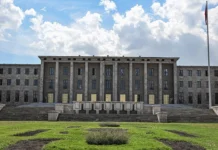
With 11 more arrests ordered by an İstanbul court on Monday, the number of people arrested for allegedly resisting law enforcement on May Day in İstanbul has risen to 49, Turkish Minute reported, citing the state-run TRT Haber.
On Sunday 38 people who were among 65 who were detained last week for attempting to hold a demonstration in İstanbul’s Taksim Square to mark International Workers’ Day despite a government ban were arrested. The other demonstrators were released, some under judicial supervision.
On the same day Interior Minister Ali Yerlikaya announced the detention of 12 other demonstrators who attempted to march from the Saraçhane neighborhood to Taksim Square, which has symbolic importance for the demonstrators, on May Day by trying to break through the police blockade.
Eleven of the detainees were arrested on Monday after appearing in court.
The arrestees are accused of violating the law on assemblies and demonstrations, disseminating the propaganda of a terrorist organization, resisting a public officer and damaging public property.
More than 42,000 law enforcement officers were deployed in İstanbul on International Workers’ Day to prevent demonstrators from reaching central Taksim Square, where they wanted to hold a demonstration.
The Interior Ministry and the İstanbul Governor’s Office announced before May Day that no demonstrations would be allowed in Taksim due to security concerns, sparking a backlash from some opposition parties, labor unions and civil society groups.
When the demonstrators wanted to march from Saraçhane to Taksim, they faced dozens of riot police who were deployed in streets leading to the square as well as to the historic Aqueduct of Valens, built in the late 4th century to supply water to Constantinople, the capital of the Eastern Roman Empire. Photos showing police officers in front of the structure led to questions of whether they were deployed to defend the city from foreign invaders or from Turkish citizens who wanted to hold a peaceful demonstration.
The symbolic importance of Taksim Square stems from the killing of 34 people by unknown assailants on May Day in 1977. The area has become a subject of tension and confrontation between the government and labor unions in the days leading up to May Day since 2013.
Until 2009, Taksim was off limits to demonstrators following Bloody May Day in 1977. About three decades after the incident, under tight security, Taksim Square became the venue of peaceful demonstrations aside from a few minor incidents in 2010, 2011 and 2012. The area was closed to demonstrations again in 2013 out of security concerns.














